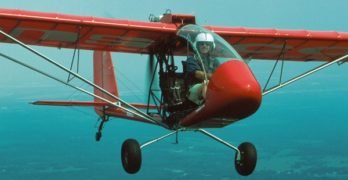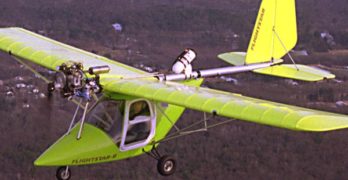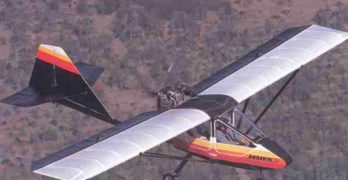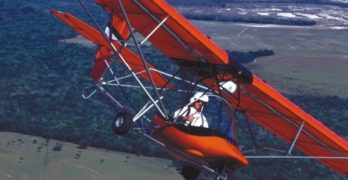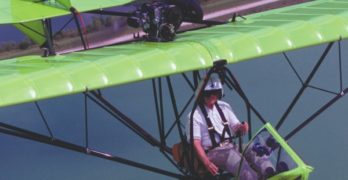“RANS is back!”
said many ultralight enthusiasts when the company offered their production version of the S-17 Stinger in September, 1999. Now the Kansas company has reaffirmed their commitment to the ultralight community by offering an enlarged S-17 with an added, tandem seat. Welcome to the S-18 Stinger II.
Of course this isn’t the first ultralight trainer from RANS. They continue to sell their S-12XL Airaile 2-seater. Others may observe that the S-6 Coyote 2-place can be built to operate within the limits of the Part 103 training exemption.
But when RANS first talked about their single-place Stinger – the prototype model that was never marketed – the company had been going in another direction. In those days the apparent darling of the company was the S-16 Shekari that is more accurately described as competition for Van’s RV series than as an ultralight. RANS president Randy Schlitter was able to see that ultralights didn’t simply grow up and become “light aircraft.” And, since Schlitter wants a share of the ultralight community, the S-17 single-place Stinger was his 1999 entry to entice ultralight flyers to the RANS brand name.
Search Results for : electric
Not finding exactly what you expected? Try our advanced search option.
Select a manufacturer to go straight to all our content about that manufacturer.
Select an aircraft model to go straight to all our content about that model.
Product Lines – April 04
St. Paul, Minn. — You’ll probably be amazed to hear that Wallaby Ranch and Quest have merged. Yes, unbelievably, the two rivals flight parks signed an agreement to become as one. • This stunning development comes just after Wills Wing purchased Moyes “for a song” crooned WW president, Rob Kells. “It seemed like a good idea at the time,” he added. How much more shocking news can you withstand? Well, in keeping with a few fun items elsewhere in this magazine, the above is pure April Fools fiction. I’ll leave more inventive humor to others and return to what this column does best. ••• Amid all the excitement, I completely forgot to blow my own horn… Yup, with the February 2004 issue, “Product Lines” finished 25 years of continuous publishing. In all that time, the column never missed an issue. As I am working to post all these columns on my long-in-development Web site, someday you’ll be able to scan through a lot of hang gliding history presented in a familiar format.
Product Lines – November 02
ST. PAUL, MINN. — Tucks and tumbles and tails and winglets. What’s happening out there? Rigid wings had good showings at recent competitions and their participation in places with stronger conditions has revealed the value of a fixed tail. Aeros has also fitted sleek winglets to their Stalker 2. My guess is more controlling surfaces are headed our way. At last summer’s Worlds approximately a third of the rigid wing pilots flew with tail-equipped wings. Some pilots have even made the normally fixed tails moveable. Alex Ploner reportedly installed an electric servo motor on his tail which allows him to set the angle of the tail for climb and glide. At minimum, tails cause a damping of control bar movements which helps in distance flying by reducing fatigue. It isn’t clear if the tail alters the likelihood of the glider tucking or tumbling but contest pilots have said they’ve been helped with a higher confidence level.
Product Lines – February 04
ST. PAUL, MINN. — More news seems to surround power and hang gliders or paragliders.
Why? Well| first, it’s winter. Less flying occurs, at least in the northern latitudes.
So pilots are talking about gear and powered harnesses and nanotrikes
are part of the discussion. Secondly, expressions of interest by soaring pilots may
be a result of USHGA gaining member approval for adding these machines to the mix
(nanotrikes are not presently included; only foot launched aircraft). Add one more
fact, the steadily-increasing age of HG&PG pilots, and no one should be
surprised that discussion includes power (and wheels). With that in mind, I like
to dispense with one item right now.
Corrections Dept.: In August last year, I wrote about some spectacularly high
flights accomplished by Minnesota pilots using powered harnesses for their initial
launch into huge thermals. I also said, because that’s what I understood, that all
four pilots reaching 10,000 feet AGL used NRG Mosquito harnesses sold by Bill
Fifer of Traverse City Hang Gliders.
The First Two Ultralights with the New HKS Engine
It isn’t often I can do “scouting party” duty on engines. Powerplants aren’t normally my focus. They
are a necessity for flight, but they aren’t my main attraction. A great many pilots I’ve met appear to be just the reverse: They are extremely interested in engines.
I enjoyed the chance to fly behind the first European and first American installations of the new 60-hp HKS 700E 4-stroke from Japan’s HKS Company Ltd. With that in mind, this pilot’s report is rather different. We’ll look at this new engine on two different aircraft.
As all Ultralight Flying! readers know, Rotax has enjoyed great success for more than a decade as an ultralight engine supplier. After dominating the 2-stroke market, Rotax introduced the 81-hp Rotax 912 4-stroke, which has become a popular powerplant choice for sport aviation aircraft.
Is a 4-Stroke Better?
All 4-stroke engine manufacturers trumpet their advantages over 2-strokes: lower fuel consumption, quieter operation, longer time between overhaul, and reliability.
Why Not Rotax?
So, Why Not Stick With Rotax?
Why take a chance with any new brand, even if it is a Japanese engine? Why not stick with a familiar brand name?
HPower’s Tom Peghiny relates airshow conversations with a wide range of sport aviators, not only ultralight pilots. He reports: “Not a single person wanted to compare price or weight with the Rotax 582, against which the HKS engine competes. In fact,” he adds, “they overwhelmingly said simply, ‘Thanks!’ for offering an alternative.”
A few good reasons explain why the 700E may represent a better value than the 582. On the face of it, a ready-to-fly 582 will run about $5,400 retail, while the 700E is $6,500 with stainless steel exhaust.
The extra cost comes from the parts count on a 4-stroke engine. More pieces cost more money. And to make these engines last longer, they must be built of components that can endure long operating periods.
CGS Aviation – Hawk II Arrow
You get two things when you buy a Hawk: the airplane and Chuck. The Hawk will cost you a shade over $9,000 (single place; 447 engine). Chuck comes free with the deal. CGS boss Slusarczyk is a fascinating character and when he starts talking, a crowd often gathers.
He’s also a forward-thinking designer. Eleven years ago, CGS Aviation was the first to abandon the silly FAA requirement that ultralights had to be foot launchable. The fully enclosed Hawk set the industry on its ear and never looked back.
Today’s Hawk has seen many refinements but the basic idea was so good it continues to sell. That’s because a Hawk does most things right, making its owners some of the most loyal I’ve ever met.
The cabin is spacious and refinements to the Hawk Arrow make it more comfortable and usable than before. It flies conventionally with very predictable handling, strong performance, and it takes off and lands like you had an autopilot engaged.
Getting Up On A Breese
A M-Squared solidifies its position in the ultralight industry, the company rounds out its line of models with a pair of single-seaters to complement two 2-seaters already completed.
Welcome to fresh Mississippi Breeses.
M-Squared was born of a collaboration of 17-year Quicksilver veteran Paul Mather, and South Mississippi Light Aircraft (SMLA) owner Ronnie Smith. Mather started and solely owns M-Squared, but the two men have established a complementary working relationship.
Ronnie Smith and his wife built their SMLA operation into a regional powerhouse, selling Quicksilvers and other models through a chain of subdealers. Smith also established the southern enterprise as one of the few official American Rotax sales and service outlets and is also a supplier of many ultralight accessory items.
Mather conceived how Smith’s presence in the business might be combined with his own depth of experience and M-Squared rose as powerfully as the early 80-hp Rotax 912-equipped aircraft he debuted in the spring of 1997.
Golden Circle Air’s T-Bird I Is Easy On Pilots
Ten years ago, in the spring of ’93, I flew and reported on the nosewheel T-Bird I. Part 103 was barely 10 years old then and Sport Pilot/Light-Sport Aircraft concepts were a decade in the distant future.
This month we’re going to take a look at the taildragger T-Bird model. The good news through this passage of time is that the T-Bird I remains a delightful aircraft to fly. Anyone entering ultralight aviation should consider this plane among the fleet of possibilities.
Maybe you’re a bit overwhelmed by the steady stream of talk about FAA’s proposed Light-Sport Aircraft rule. The concept may be a bright light on the aviation horizon, but with another 6 months or more to wait, the patience of many pilots is wearing thin.
Even though I’m excited about this proposed new class of aircraft, I remain a true believer in the lighter, simpler, less expensive theory of ultralight aircraft.
Airtime Products Powerlite Trike
Combo to consider: light trikes and the ATOS wing.
Attention may be centered on SportPlanes™these days, but many aircraft in the rest of the world of Light Stuff can fly on as if no new regulation were pending. Such aircraft include the range of what the FAA calls ultralight vehicles, but this category isn’t limited to the U.S.
At least through the next three-plus years, two-place trainer ultralights may still operate under their present-day programs. But this month we focus on genuine, by-the-numbers, single-place ultralight vehicles, just as Part 103 rule-writer Mike Sacrey intended.
The U.S. isn’t the only country allowing very light aircraft to fly under relaxed rules. England has a sub-70 (kilogram) rule that permits powered hang gliders and superlight trikes. Australia also permits these light machines. For such machines in the U.S., Federal Air Regulation Part 103 remains the relevant rule.
Introducing Airtime Products
Continuing the theme of international brands reaching U.S.
- « Previous Page
- 1
- …
- 57
- 58
- 59
- 60
- 61
- …
- 67
- Next Page »


